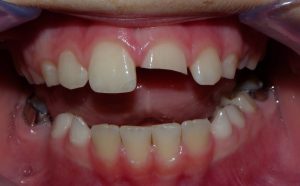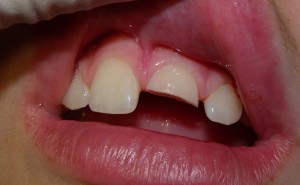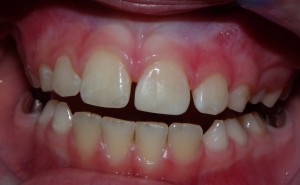Well, you’ve broken your front tooth. Now what?
Posted: June 12, 2011
Last Modified: June 6, 2022
One of our guiding principles is that there is no tooth better than natural tooth. We try to conserve as much original tooth as reasonable when things like decay occur, but when there is trauma and the original tooth is broken, we’ve got to try and repair it with something that will hopefully last. Nothing will ever last as well as the real thing, but our materials get better and better. Here is a case where a front tooth was hit during routine childhood play:

Fortunately, the fracture did not extend to the pulp (nerve area) of the tooth. If that had happened, a root canal would have been required to save the tooth. Here’s another look at the fracture:

Since there did not appear to be pulpal involvement nor any vertical root fractures, we decided that the tooth was indeed savable, and with only a simple composite resin (white filling) buildup!
The buildup: after local anesthesia, the tooth was roughened around its periphery in order to create a larger surface area for bonding. We blended three different colours of filling material (EsthetX HD) to create different effects: WO at the back to create some white background opacity (otherwise the filling would allow the darkness of the mouth to show through), A1 to create the main body shade, and WE to create the look of translucency at the edge of the tooth. Here’s the result:

We think it looks nice. However, this is not the end of the story. Some notable information:
– if the broken fragment had been retrieved, we may possibly have been able to REBOND the piece! This would be much better and quicker than a buildup. Of course, re-fracture would be a risk no matter what type of restoration we performed.
– although the nerve was still testing normally at the time of presentation to our office, there is no telling how it will react in the long term. Colour changes, pain, or swelling/drainage from the area would be clear signs that the pulp is dying, making root canal treatment necessary.
– sometimes trauma will cause painless consequences to the exterior of the root as well – sometimes the body will start resorbing the root, sometimes the root will fuse to the bone. These things cannot be seen, and will require routine long-term follow-up. If these things happen, extraction of the tooth followed by replacement would be required.
– if the tooth remains intact and alive, a fracture of this size warrants a crown. We will generally postpone a crown until the patient reaches the age of 18-19 as the position and gums of the tooth are still subject to change. And as we mentioned earlier, nothing lasts as long as real tooth, so if a crown lasts 20 years and is placed on an 18 year old, it will likely need to be changed several times throughout the patient’s life. Better to postpone that first crown, but sometimes we fear fracture so much that we have no choice but to proceed with the crown anyways.
So, save your broken tooth-pieces and see your dentist ASAP. We will be pleased to see you for such emergencies and offer individual advice for your tooth. Please contact us!


